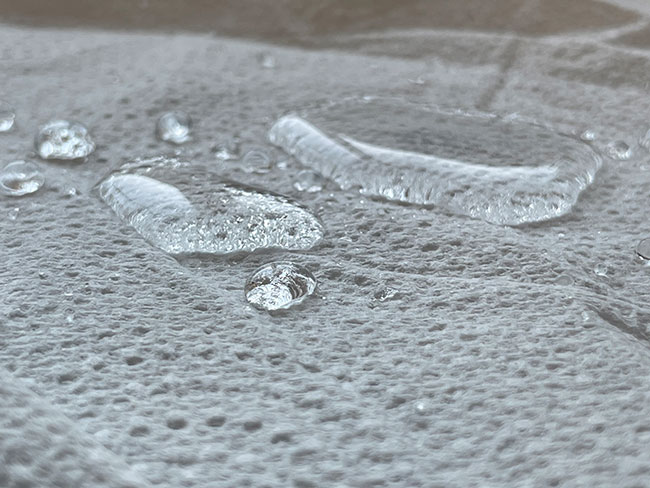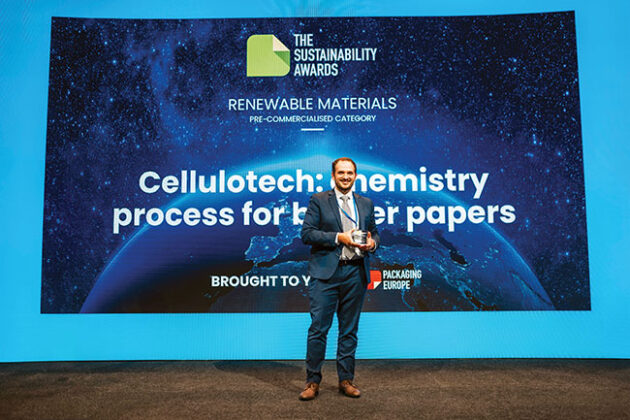
Features
Paper
Research & Innovation
Paper protection 2.0: Exploring an innovative method of protecting paper products
March 25, 2024 By Jack Kazmierski
 Cellulotech’s molecular grafting process makes paper products hydrophobic, without the need for a coating.
Photo: Cellulotech
Cellulotech’s molecular grafting process makes paper products hydrophobic, without the need for a coating.
Photo: Cellulotech Canadian startup, Cellulotech, recently received an award from Packaging Europe in the Pre-Commercialized Renewable Material Sustainability category. This award recognized the company’s technology, which addresses the need of the industry to move towards repulpable barriers, without any plastic or other unsustainable materials. Instead, Cellulotech employs a process, discovered by its scientific director, Daniel Samain, that grafts one-nanometer-long molecules and offers a wide range of barrier properties.
Cellulotech shares that not only is this solution effective, but it also reduces costs, since it uses hundreds of times less material per square metre than traditional coatings. It also maintains the recyclability of the paper products, while lowering CO2 emission levels associated with traditional coating processes.
Coating vs. molecular grafting
Understanding Cellulotech’s solution requires a bit of out-of-the-box thinking. “This is not a coating,” stresses Romain Metivet, founder and CEO of Cellulotech. “We’re not adding a layer of material to the paper in order to protect it. Rather, we’re using molecular grafting to attach tiny molecules one nanometer long around the fibre.”
Metivet says that this patented process does not change the way the paper feels or how much it weighs. “There’s no layer of material on top of the paper,” he adds. “This is a chemical barrier that changes the surface properties of the paper, without you seeing it.”
To better explain the concept, Metivet offers the example of water and oil poured together into a glass. Naturally, they won’t mix. Instead, they’ll remain separate. “This is the exact same phenomenon,” he says. “We attach tiny fatty molecules around the fibres, and water basically just flows off the paper, instead of being absorbed by it. The best way to think of it is that we turn paper into Gore-tex. The paper becomes super-hydrophobic, but it still breathes, because we don’t close the pores of the paper like a coating would. Moreover, this treatment can last decades.”
It is quite interesting that this innovative process doesn’t simply treat the surface of the paper. “It’s applied to the specific surface,” Metivet explains, “which means that we treat the full thickness of the paper. In addition, you have no more capillary uptake, and you can fold or cut the paper without damaging the barrier properties. The paper is always protected.”
Moreover, this advanced process doesn’t interfere with a paper product’s recyclability, Metivet explains. “You can recycle it as you would normal paper,” he adds.
An affordable solution
One of the key advantages of Cellulotech’s solution is that the reagent used in this process is bio-sourced, readily available on the market and very affordable. More importantly, only a small amount of this reagent is needed to get the job done.
“We use a very tiny amount of reagent because this is a chemical reaction, and we don’t need to add a big layer of material to the paper,” Metivet says.
“Depending on the paper,” Metivet adds, “we need between 20 and 100 mg of reagent per square metre, and at $4 per kilogram, you will not find a cheaper solution. When you add up all the savings, this process is dozens of times cheaper than traditional coating technologies. It can also reduce creep and grammage and become a new sizing standard, reducing production costs significantly.”
Metivet estimates the cost of this technology to be between 0.1 and 0.5 cents per square metre, depending on the substrate.

Romain Metivet, founder and CEO of Cellulotech accepts the award from Packaging Europe.
Photo: Packaging Europe
Advanced application process
The reagent is applied to the final paper product through a hot and dry process, which can be adapted to work with three-dimensional moulded pulp objects like cups or trays. It can also enhance papers coated with hydrophilic coatings, such as MFC or PVOH, thereby enhancing their barrier properties to water and vapour, while offering recyclable plastic or silicon-like barrier properties.
Currently, however, the equipment needed for this molecular grafting process to work on a large scale isn’t available on the market. It still has to be developed, built and tested before Cellulotech can start offering this technology to paper mills for large-scale applications. “Right now,” Metivet adds, “we’re looking for the partners and the financing we’re going to need to scale up the process.”
One of the challenges Metivet and his team are dealing with is the fact that isn’t possible to simply retrofit existing coating machines to work with this new nanotechnology. “The reaction time is 0.1 seconds,” he adds, “so it’s very, very fast. The reaction itself takes place in what we call a liquid-gas equilibrium phase. This means we apply the reagent as a very thin layer of liquid, but it spreads across the surface as a gas. That’s why we need dedicated equipment.”
Cellulotech is now in talks with several companies to scale up, and they’re planning to launch industrial pilots in North America and Europe. “Once the pilot project is ready,” Metivet adds, “any equipment manufacturer would be able to make the equipment. We would have the blueprints, and they could easily make it. It’s not that complicated.”
Metivet estimates that the entire turn-key process, complete with the necessary equipment, will be ready for paper mills in about four or five years. “We will have it ready within a couple of years for converters running at lower speeds,” he adds, “but for mills that are running at 1,000 metres per minute or more with a four- or five-metre wide machine, it would be overly optimistic for me to say that we would be ready within a couple of years.”
New markets, new products
Once this technology is ready to go to market, Metivet says it will open up new possibilities for paper products. For example, this process can be used to make paper face masks that will be able to repel droplets containing viruses and microbes, while also allowing the wearer to breathe freely.
Another application suggested by Metivet is paper that will be able to remove oil spills in the ocean or in industrial applications. “We can treat a paper towel,” he explains, “and make it hydrophobic. So, it won’t absorb water, but it will absorb spilled oil. This means we will be able to remove oil spills with a paper-based solution that is cheaper to manufacture but offers tremendous value.”
This technology also opens new high-added-value markets for paper used in construction, or even for water desalination.
Metivet is certain that he can move through the pilot project phase and bring this new technology to market without any major hiccups. “We want to get there quickly, and we have a clear roadmap for what’s ahead,” he says. “This is an innovation that’s going to take a few years to get to scale, but once it does, it’s going to change everything. We are convinced our technology will reshape the vast paper and packaging industries and change the way we think about biomaterials. Paper is the material of the future, and we’re very excited about it.”
Jack Kazmierski is a Toronto-based freelance journalist and photographer.
Print this page